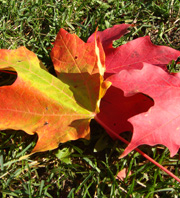The Science of Fall Colors
Ochen Kaylan
OCTOBER 18, 2008
- Maple leaves in mid-color change.
- (Ochen Kaylan)
- View the Slideshow
Web Resources
Related Stories
- Garageland: Hydrogen in the Garage
- Pollution Smells Like Pumpkin Pie
- Crazy for Time Capsules
- Conversations with America: Oliver Sacks
More From Ochen Kaylan
If you're in a part of the country dominated by coniferous trees, with needles instead of leaves, this time of year is just about getting colder. But if your landscape features deciduous trees, it is technicolor outside. But, why do the leaves change color? What's actually happening in that tree? We're gonna get all educational. Producer Ochen Kaylan headed out with a real live scientist to try to understand what's going on inside the leaf.
---
Bud Markhart: I grew up in Western Massachusetts. The epicenter for fall colors. I used to spend a lot of time just walking through the woods and watching nature, and lying on the ground, feeling the maple leaves fall on me as the wind blew, and just being almost a snow angel in the leaves, and moving my arms and my legs back and forth and feeling the rustling of the dry leaves and watching the colors come down through the blue sky.
Ochen Kaylan: Can you start by telling me your name?
Markhart: Sure, Bud Markhart, I'm on the faculty of the University of Minnesota, department of horticultural science.
We've in the Como Conservatory gardens. We're having a beautiful day under a bright blue sky here, enjoying the colors of the park.
Yeah, the science behind it is the yellows comes from pigments from anthocyanin and carotenoids. Those are pigments that are there in the leaves all the time; we just can't see them because the leaves have so much chlorophyll and the plants are actively photosynthesizing, and the chlorophyll dominates the yellows.
Kaylan: So hold on. So we've got three things here. We've got chlorophyll, which I've heard of before, and the two other things?
Markhart: The chlorophyll is the green pigment, and then in addition to that, we have the yellow pigments which are called carotenoids and xanthophylls.
Kaylan: And what are they good for? Why do they exist?
Markhart: They're there all the time to protect the chlorophyll so that it's not damaged by too much sun or stressful conditions. When a leaf is photosynthesizing, it's a really high-energy process. There's all this sunlight coming in, and it's exciting all these electrons, and these electrons are going around and trying to make food. And boy, if there's too much energy, those excited electrons can cause a lot of damages. If you take a bunch of teenagers and put them in a room with nothing to do, boy, look out. They're going to start raising a lot of heck. And that's what all these electrons will do to. It's the carotenoids and the xanthophylls that help keep those electrons under control and give them some place to go so they don't cause a lot of damage.
Kaylan: So these are jut little things that are in the leaf that are doing their job maintaining, and they just happen to have a color to them?
Markhart: Right, they happen to have a color. When they know that it's time to take all that energy out of the leaves and put it into the root system, the first thing they do is they break down all the chlorophyll molecules, because the chlorophyll has a lot of important nutrients and resources in there. So when it get's rid of the chlorophyll, what's left is the xanthophylls and the carotenoids, and that's why we get yellow color.
One of the real mysteries is what is the biochemical mechanism by which plants sense that shortening of the day?
Kaylan: So just the most basic trigger of when it's time to change color, we don't know?
Markhart: We understand some of the mechanisms, I'd say. We just don't have a full picture yet. We know it's a change in day-length. But we don't know exactly how that change in day length is transformed into all of those changes that need to take place to change the colors.
Kaylan: I find that amazing. When we think of mysteries in science, we think of water on Mars or what life forms are in the deep sea. But in our own back yard, we don't entirely know what's going on.
Markhart: That's right. There's still a lot of wonderful mystery that's out there. That's why plants physiologist or horticulturalists still have jobs, because there's still a lot for us to discover.
-
- Music Bridge:
- Asher
- Artist: Steven Bernstein
- CD: Diaspora Suite (Tzadik)







Comments
Comment | Refresh
Post a Comment: Please be civil, brief and relevant.
Email addresses are never displayed, but they are required to confirm your comments. All comments are moderated. Weekend America reserves the right to edit any comments on this site and to read them on the air if they are extra-interesting. Please read the Comment Guidelines before posting.
You must be 13 or over to submit information to American Public Media. The information entered into this form will not be used to send unsolicited email and will not be sold to a third party. For more information see Terms and Conditions and Privacy Policy.